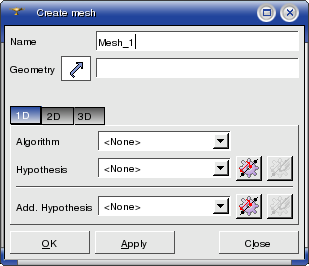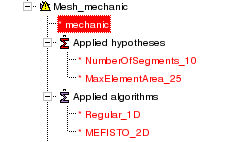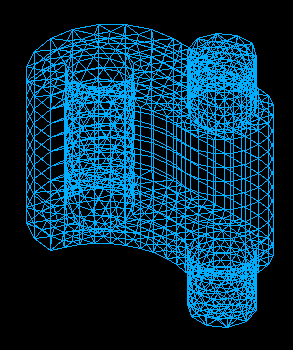 button in the toolbar. The following dialog box will
appear:
button in the toolbar. The following dialog box will
appear:Construction of a mesh consists of:
Selecting a geometrical object for meshing
Applying meshing algorithms and hypotheses which will be used at computation of this mesh.
To construct a mesh:
1. In the Mesh
menu select Create Mesh or
click  button in the toolbar. The following dialog box will
appear:
button in the toolbar. The following dialog box will
appear:

2. For example, you need to mesh a 3d object.
First, type the name for your mesh in the
"Name" box, by default, it is "Mesh_1". Then select
the object you wish to mesh in the Object Browser  and click
the
and click
the  "Add" button.
"Add" button.
Now you can define 1d Algorithm and 1d Hypotheses,
which will be applied to the edges of your object. (Note that any object
has edges, even if their existence is not apparent, for example, a sphere
has 4 edges). Click the  button to add a hypothesis. Click the
button to add a hypothesis. Click the  button
to define values for the current hypothesis. The use of additional hypotheses
is optional (i.e. you may leave "None" in this box).
button
to define values for the current hypothesis. The use of additional hypotheses
is optional (i.e. you may leave "None" in this box).
Proceed in the same way with 2d and 3d Algorithms and Hypotheses, note that the choice of hypotheses depends on the algorithm. There must be one Algorithm and one or several Hypotheses for each dimension of your object, otherwise you will not get any mesh at all. Of course, if you wish to mesh a face, which is a 2d object, you don't need to define 3d Algorithm and Hypotheses.
In the Object
Browser the structure of the new mesh will be displayed as follows:
It contains:
a reference to the geometrical object on the basis of which the mesh has been constructed;
Applied hypotheses folder containing the references to the hypotheses applied to the construction of the mesh;
Applied algorithms folder containing the references to the algorithms applied to the construction of the mesh.
3. Now, when everything is ready, select
your mesh in the Object Browser.
From
the Mesh menu select Compute or click  button of the toolbar.
button of the toolbar.
If you've done everything right, you'll obtain
something like this. 
Consider trying a sample script for construction of a mesh from our TUI Scripts section.